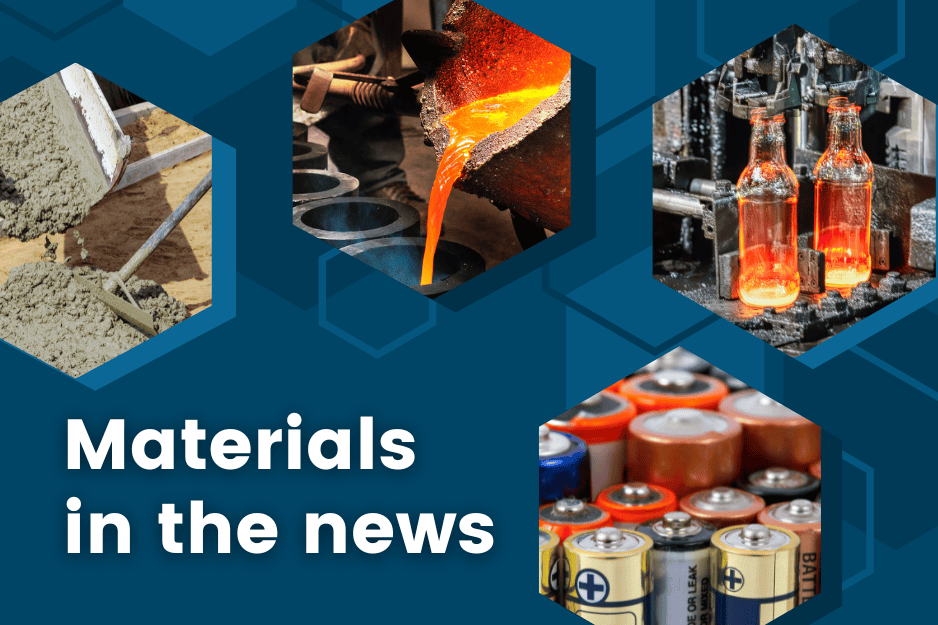
[Image above] Credit: ACerS
NANOMATERIALS
Physicists find unexpected crystals of electrons in graphene
Massachusetts Institute of Technology physicists reported electrons forming crystalline structures in rhombohedral pentalayer graphene depending on the voltage applied to the material in ultralow-temperature conditions.
Strong as steel, light as foam: Nano-3D printing produces breakthrough carbon materials
Researchers at the University of Toronto and Korea Advanced Institute of Science and Technology used machine learning to design nano-architected carbon materials that have the strength of carbon steel but the lightness of Styrofoam.
ENERGY
Scientists design novel battery that runs on atomic waste
Researchers led by The Ohio State University demonstrated that ambient gamma radiation could be harvested to produce a strong enough electric output to power microelectronics, such as microchips.
Chinese researchers develop new lithium–hydrogen battery
Researchers at the University of Science and Technology of China created a battery that uses hydrogen gas as the anode instead of lithium derivatives. They say the new battery model has a theoretical energy density of 2,825 watt-hours per kilogram, with steady operational voltage of about three volts.
ENVIRONMENT
Brewing tea removes lead from water
Northwestern University researchers demonstrated that brewing tea naturally adsorbs heavy metals such as lead and cadmium, effectively filtering dangerous contaminants out of drinks.
Geothermal waste-based grout boosts earthquake resistance by 50%
Researchers in Japan used waste fluids from geothermal energy plants to create a new grout material that improves soil stability significantly. Laboratory tests showed the new grout improves liquefaction resistance by 50% compared to traditional grouting materials.
Coating air filters with MXenes can enhance performance and reusability
An interdisciplinary team of Drexel University researchers showed that a nonwoven polyester textile coated with a thin layer of MXene turns into a potent filter capable of pulling some of the finest nanoparticles from the air.
Scientists discover low-cost way to trap carbon using common rocks
Stanford University chemists demonstrated a new process for converting slow-weathering silicates into much more reactive minerals that capture and store atmospheric carbon quickly.
MANUFACTURING
Extremely low friction thanks to new solid-state lubricant
By combining organic and inorganic chemistry, TU Wien researchers developed a new lubricant called COK-47. This powdery lubricant consists of stacks of atomically thin sheets. The platelets can slide past each other very easily when in contact with water, which ensures extremely low friction.
Water-repellent glass breaks new ground
Curtin University researchers developed a new technique to make glass water-repellent. The process uses ultrasound to trigger a chemical reaction that permanently alters the surface of glass.
Switching fiber optic cables from round to rectangular shown to enhance data speeds
Researchers from the University of Iowa discovered that fiber optic cables with rectangular rather than the conventional circular cross-section achieve significantly enhanced information transfer rates.
Modifying graphene with plasma to produce better gas sensors
Chiba University researchers developed an improved gas-sensing technology by treating graphene sheets with plasma under different conditions, creating structural and chemical defects that enhance ammonia detection.
OTHER STORIES
High-performance oxide-ion conductors using rubidium
Institute of Science Tokyo researchers discovered a rare rubidium-containing oxide-ion conductor, Rb₅BiMo₄O₁₆, with exceptionally high conductivity. Identified through computational screening and experiments, its superior performance stems from low activation energy and structural features such as large free volume and tetrahedral motion.
Incipient ferroelectricity could jumpstart fast, low-power electronics
Researchers at The Pennsylvania State University harnessed incipient ferroelectricity to develop multifunctional, 2D field-effect transistors. Incipient ferroelectricity refers to materials that show signs of temporary, scattered polarization. While this trait is often considered a limitation, the researchers found it became more traditional at colder temperatures.
Novel photochromic glass can store rewritable 3D patterns
Researchers developed a doped photochromic glass that has the potential to store rewritable data indefinitely. The glass is made of gallium silicate modified with magnesium and terbium ions. The researchers used a green 532-nm-wavelength laser to inscribe 3D patterns into tiny slabs of the doped glass.
Why is Mars red? Scientists find support for alternative theory
Researchers led by Brown University found support for the theory that the water-rich iron mineral ferrihydrite may be the main culprit behind Mars’ reddish dust. This theory runs counter to the prevailing theory that hematite is the reason for the planet’s color. If confirmed, it could point to Mars having a wetter and potentially more habitable past.
Author
Lisa McDonald
CTT Categories
- Weekly Column: “Other materials”